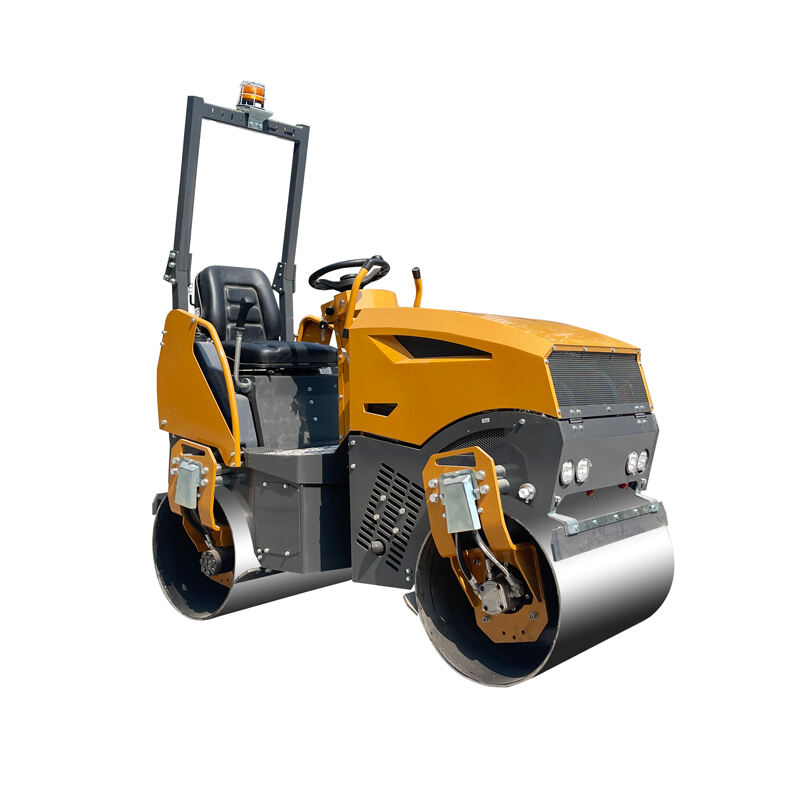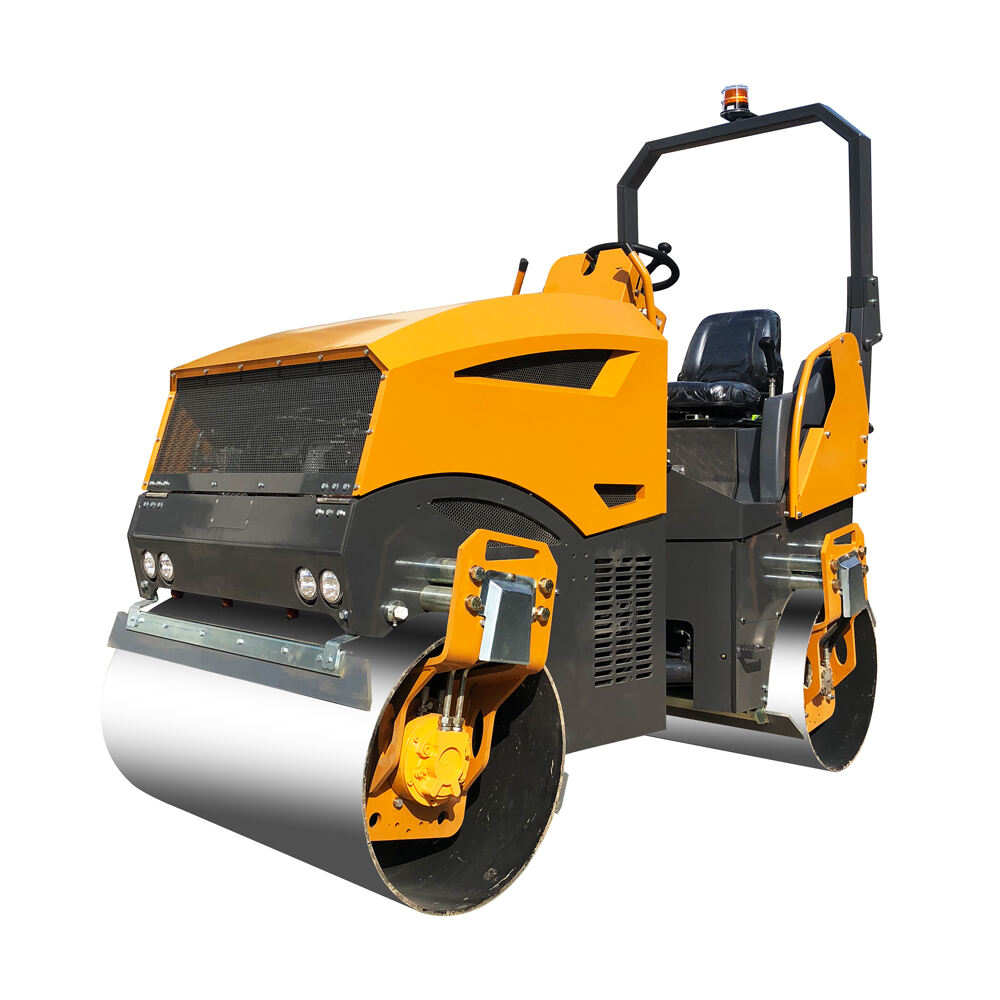Საპროექტო გზის დახვეწის მართლივი არჩევა
Გზების დახვეწების ტიპებისა და მათი გამოყენების გასაგება
Ვიბრაციული დახვეწები vs სტატიკური დახვეწები
Გზის მშენებლობაში როგორც ვიბრაციული, ასევე სტატიკური რულეტებს თავისი ადგილი აქვთ სამუშაო ადგილზე. ვიბრაციული მოდელები ხშირად იყენებენ ჰიდროსტატიკურ ძრავებს, რომლებიც ქმნიან იმ დამახასიათებელ შეშლის მოძრაობას, რაც მასალას უფრო ღრმად ატკეპავს, ვიდრე ჩვეულებრივი როლის შემთხვევაში ხდება. გზის მშენებლები ამ მოწყობილობებს განსაკუთრებით მოხმარებულად თვლიან ასფალტის გაშლისას ან თავისუფალი აგრეგატების, როგორიცაა ქვიშა და გვრილი ქვა, მუშაობისას, ვინაიდან ისინი ზედა ფენას სრულიად დაამაგრებენ. სტატიკური რულეტები სრულიად განსხვავებულ მიდგომას უსახავს საქმეში. ასეთი მანქანები თავისი მასიური წონით დაეყრდნობიან ნებისმიერი მასალის შეკუმშვას. ისინი მოხმარებულია გასამკურნალოდ როგორც თიხნარი მიწების შემთხვევაში, სადაც ვიბრაცია არაფრის გაკეთებას შეძლებდა ისედაც. კვლევები აჩვენებს, რომ ვიბრაციული მოწყობილობები შეიძლება შეკუმშვის სიმკვრივეში 20-30 პროცენტით უკეთეს შედეგს მოაქციონ, ვიდრე ძველი ტიპის სტატიკური მოწყობილობები. ასეთი სხვაობა მნიშვნელოვან როლს თამაშობს მასივის შესაკუმშად, როდესაც მომხმარებლები სპეციფიკაციის მოთხოვნებს ახალი გზების ასაშენად ან მნიშვნელოვანი ინფრასტრუქტურის გასაუმჯობესებლად ცდილობენ.
Ისწავლეთ მეტი Vibratory Roller შესახებ.
Ასფალტის გამოწვევები ზედაპირის კომპაქტირებისთვის
Ასფალტისგან დამზადებული როლერები გზების მშენებლობისას მნიშვნელოვან როლს თამაშობს ზედაპირების შეკუმშვაში, რათა გზები გლუვი იყოს და ხანგრძლივად გამძლეობდეს. როდესაც ეს მანქანები გადაადის ასფალტზე, ისინი სხვადასხვა ფენებში თანაბრად ანაწილებს წნევას, რაც გზას უფრო მკვრივს და მეტად მაშინდელ ხდის ცვეთის მიმართ. კვლევები აჩვენებს, რომ სწორი როლირება ზედაპირის სიმკვრივეს 20-25 პროცენტით ამაღლებს, რაც ნიშნავს, რომ გზები უფრო ხანგრძლივად შენარჩუნდება სატრანსპორტო მოძრაობის დროს. ბაზარზე ამჟამად სხვადასხვა ტიპის როლერებია ხელმისაწვდომი, მათ შორის ტანდემური მოდელები ორი ბარაბანით ერთმანეთის გვერდით, პნევმატიკური როლერები ჰაერის ჩანთებით, რომლებიც ავტომატურად ახდენს წნევის გადამწმენდს, ასევე ამ ორი სტილის კომბინაცია. ტანდემური როლერები მშვიდობით ასრულებს მუშაობას იმ გამო რომ ბარაბანები ერთად მუშაობენ, ხოლო პნევმატიკური ვერსიები უკეთ უმკლავდებიან მგრძნობიარე ფენებს, ვინაიდან მომხმარებელს შეუძლია დაარეგულიროს რამდენად მკვეთრად უნდა დააჭიროს მასალაზე, რომელთან საქმე აქვს მოცემულ მომენტში.
Გაიგეთ მეტი Asphalt Roller-ის შესახებ.
Აირჩიეთ Single-Drum და Tandem Rollers-ის შორის
Როლერების სხვადასხვა ტიპების არჩევა დამოკიდებულია იმ სამუშაოს ტიპზე. დიდი ნაკვეთების დასამუშავებლად, სადაც მოჭრილი მიწა და ქვიშაა, გამოიყენება ერთდრუნიანი როლერები, რადგან ისინი სწრაფად ასრულებენ სამუშაოს წინა დრუნის მაღალი წონის გამო. მშენებლები საუკეთესო არჩევანად თვლიან მათ საფუძვლების მოწყობისას, თუმცა ისინი არ იძლევიან იმ გლუვ დასასრულს, რაც საბოლოო სამუშაოს საჭიროებს. თანდემურ როლერებს აქვთ დრუნები წინ და უკან, რაც ხდის მათ საუკეთესო არჩევანად ასფალტის მუშაობისას, სადაც მნიშვნელოვანია წნევის თანაბარობა. უმეტესობა მშენებელთა ამბობს, რომ ნებისმიერი მიწის მუშაობისას საუკეთესო არჩევანია ერთდრუნიანი როლერი, რადგან ის სწრაფად და მკაცრად აკეთებს სამუშაოს. თუმცა როდესაც საუბარი მიდის გზების ან საპარკინგოების სამუშაოზე, თანდემური მოდელები გაუმჯობესებელია, მიუხედავად მათი მაღალი ექსპლუატაციის ხარჯებისა. სხვაობა საკმარისად მარტივია: ერთდრუნიანი როლერები უკეთ ამუშავებენ მაღალ წნევას, მაგრამ უპატიებით არიან შეზღუდულ სივრცეში, ხოლო თანდემური როლერები უკეთ გამკლავდებიან თითქმის ნებისმიერ პირობებს, გარდა იმ შემთხვევებისა, სადაც პირობები განსაკუთრებით რთულია.
Იხილეთ მეტი Single Drum Roller შესახებ.
Მთავარი ტექნიკური ფაქტორები რულერის არჩევანში
Მუშაობის წონა და კომპაქტირების ძალა
Როდესაც გზის როლერის არჩევაზე დგახართ, მნიშვნელოვანია მისი მუშაობითი წონისა და კომპაქტური ძალის გაგება. მანქანის წონა გავლენას ახდენს იმ ძალაზე, რომელსაც ის გამოიყენებს კომპაქტურობის დროს, რაც განსაზღვრავს სხვადასხვა ზედაპირის დატკეპნის ხარისხს. უფრო მძიმე მანქანები, საერთოდ, უკეთ ატკეპნენ, რადგან ისინი უფრო ღრმად შედიან მიწის მასაში. შეხედეთ რიცხვებს: გზის როლერები, რომლებიც 10-20 ტონს იწონიან, კარგად უმკლავდებიან მკვრივი მიწების დატკეპვას, ხოლო პატარა მოდელები უკეთ უმკლავდებიან ასფალტის სამუშაოებს და მსუბუქ მასალებს. წელზე განმავლობაში გაკეთებულმა გამოცდებმა აჩვენა, რომ როლერის წონასა და საბოლოო კომპაქტურობის ხარისხს შორის არსებობს ნათელი კავშირი. ამიტომ ხარჯავენ მშენებლები დროს ამ მაჩვენებლებზე ფიქრზე, სანამ შესაბამის მანქანას ყიდულობენ.
Გამოტანის სიგანე და ვიბრაციის სიხშირის გავლენა
Როდესაც გზის როლერებზე ვლაპარაკობთ, ბარათის სიგანე მნიშვნელოვნად განსხვავდება იმის მიხედვით, თუ როგორ გავრცელდება კომპაქტური ძალები ზედაპირზე. მსხილი ბარათები უფრო დიდ არეებს ფარავს ერთდროულად, რაც კომპაქტური სამუშაოების დროს აჩქარებს პროცესს, თუმცა ზოგჯერ ატყდება იმ ადგილებს, სადაც სიზუსტე ყველაზე მეტად მნიშვნელოვანია. დეტალებზე ყურადღებით დამუშავების საჭიროების შემთხვევაში, უფრო უკეთ მუშაობს ვიწრო ბარათები, რადგან ისინი უფრო იოლად იტევს კუთხეებში და შეშლების გარშემო. რა რომ სამუშაო სრულიად სწორად შესრულდეს, ამ მანქანების რხევის სიხშირე ასრულებს მნიშვნელოვან როლს, რაც საერთოდ ითვლება რხევად წუთში. ეს პარამეტრი განსაზღვრავს იმას, თუ რამდენად კარგად ურთიერთქმედებს როლერი იმ ზედაპირთან, რომელზეც მუშაობს. უმეტესობა სპეციფიკაციები რეკომენდავს გარკვეულ სიხშირეს იმის მიხედვით, თუ რა მასალას ვუმუშავებთ, მაგალითად ქვიშას, მიწას ან ასფალტს, თუმცა გამოცდილება აჩვენებს, რომ არ არსებობს საუნივერსო ამონახსნი. ბარათის ზომებისა და რხევის პარამეტრების გაგება ეხმარება მშენებლებს აირჩიონ ის მანქანა, რომელიც უკეთ შეესაბამება მათ კონკრეტულ პროექტებს, სიჩქარისა და ხარისხიანი შედეგების ბალანსის დაცვით ბიუჯეტის გატეხვის გარეშე.
Ჰიდრაულიკური სისტემები და სასამართლო საწვავი
Გზის გადამუშავებელ როლერებში ჰიდრავლიკა ასრულებს მნიშვნელოვან როლს მათი სრული შესრულების შესაძლებლობის ასამაღლებლად. ეს სისტემები დახმარებას აძლევს ოპერატორებს მუშაობის პირობების გლუვად შენარჩუნებაში ძალის მიწოდებისა და სიჩქარის გარეგნული მახასიათებლების კონტროლით, რაც პირდაპირ აისახება როლერის ზედაპირების შეკუმშვის ხარისხზე და გაუმჯობესებს ყოველდღიურ მუშაობას გუნდისთვის. ჰიდრავლიკური სისტემების მოწყობის მეთოდს მნიშვნელოვანი მნიშვნელობა აქვს საწვავის ხარჯვის მაჩვენებლებზე. ზოგიერთი ახალგაზრდა მოწყობილობა საწვავის ხარჯს ამცირებს, რადგან ის უფრო ეფექტურად ანაწილებს ძალას მანქანაში. მასალების გამოყენების შესახებ ადგილობრივი მონაცემები აჩვენებს, რომ უფრო ეფექტური ჰიდრავლიკის ინვესტიციები დროის განმავლობაში იწევს დაბალ შენარჩუნების ხარჯებს და გახანგრძლივებულ მომსახურების ვადას. ჰიდრავლიკური სისტემების ეფექტურობის არჩევა არ არის მხოლოდ კარგი ბიზნეს გადაწყვეტილება, არამედ ხელს უწყობს გზასაშენი პროექტების მეტად გამარტივებასაც.
Პროექტის მიხედვით დახურვის მოთხოვნები
Მიწის ტიპის ანალიზი როლერის არჩევანაირად
Იცოდეთ, რომელი სახის მიწას ვუმუშავებთ საუკეთესო გზას გვთავაზობს სწორი გზის როლის ასარჩევად შეკუმშვის სამუშაოებისთვის. მრეწველობა იყენებს რამდენიმე კლასიფიკაციის მეთოდს, მათ შორის USCS-ს და AASHTO სტანდარტებს მიწის დასახელებისთვის პირის ზომისა და წყლის შენახვის მიხედვით. ეს თვისებები პირდაპირ ახდენს გავლენას როლერების შესრულებაზე. უმეტესობა პროფესიონალების რეკომენდაციას უწევს სწორი მიწის ტესტების ჩატარებას მანამ, სანამ რომელიმე მოწყობილობას აირჩევენ. ქვიშიანი მიწები უმჯობეს რეაგირებს ვიბრაციულ როლერებზე, ხოლო თიხნარი მიწებისთვის საჭიროა უკეთ მოხვევა, როგორიცაა padfoot მოდელები. ამ სწრაფი მიდგომის აღება ნიშნავს, რომ არჩეული როლერი მუშაობს იმ მიწის სახით, რომელიც მშენებლობის ადგილზეა.
Მცირე მასშტაბი წინააღმდეგ გზების პროექტების მასშტაბში
Მასალების დატკეპნის საქმეში მცირე მოცულობის სამუშაოებს შორის და მასშტაბურ გზას შორის საკმაოდ დიდი სხვაობაა. უკანა მინდვრის მარშრუტების ან მეზობლობის საპარკინგო ადგილების შემთხვევაში სამუშაო ბრიგადები ჩვეულებრივ იყენებენ პატარა როლერებს, რომლებიც ისეთი მარტივად მართულია სივრცით შეზღუდული მოხმობებისა და არხების გასწვრისას. თუმცა, როდესაც მაგისტრალების ან მთავარი გზების მშენებლობა ხდება, სამუშაო ჯგუფებს სჭირდებათ დიდი მანქანები - ისეთი მანქანები, რომლებიც უმასშტაბოდ შეძლებენ ასფალტის დიდი მოცულობის დამუშაობას დამატებითი ძალისხმევის გარეშე. დიდი პროექტები იმასაც გულისხმობს, რომ ინვესტიციებიც დიდი იქნება. იმ ადამიანისთვის, ვინც ფაქტობრივად მართული აქვს მშენებლობის ადგილები, იცის, რომ სამუშაოსთვის არასწორად შერჩეული როლერის ზომა არ არის მხოლოდ სამუშაოს სიჩქარით დასრულების საკითხი. ეს პირდაპირ აისახება საბოლოო რიცხვებზე. საერთო გარბენის შესაძლოა საშუალო ზომის მანქანით უფრო სწრაფად დასრულდეს, ხოლო მცირე მანქანის გამოყენება მაგისტრალის სამუშაოებში სწრაფად იქცევა ფულის ჩანაგდების ხარჯზე.
Მანევრულობა შეკუმშულ საფარდოებში
Მნიშვნელოვანია იმის გარშემო მოხვედრა, როდესაც გზის როლები მუშაობენ შეზღუდულ ადგილებში ან ქალაქში. მანქანები შესაბამისი საჭე მექანიზმით, პატარა სივრცეში და სწრაფად მოქმედი სამართავი ღონისძიებებით ამ რთულ ვითარებებში ყველაფერს განსხვავებულად ახდენს. მაგალითად, კომპაქტური ხელსაწყოების ან მინი მანქანების გატანა ხშირად ხმარებაში არის მშენებლობის ადგილებში, სადაც სივრცე შეზღუდულია. მომხმარებლები აცხადებენ, რომ სამუშაო დასრულება უფრო სწრაფად ხდება ვიწრო ჩიტებში და ადამიანთა სიმჭიდროვეში უფრო მარტივად მართვის შედეგად. სამრეწველო სფეროში არაერთხელ დაფიქსირდა წარმატებული შედეგები იმ მანქანების გამოყენებით, რომლებმაც შესაძლოს მოუწოდა ოპერატორებს შესავლელი იძლიერეს კუთხეებში გარემოცვლილი სტრუქტურების დაზიანების გარეშე. ნულოვანი მოხვევის რადიუსის ფუნქციები და კარგი დამუხრუჭების სისტემები არ არის მხოლოდ სპეციფიკაციების სადემონსტრაციო მაგალითები, ისინი საშუალებას აძლევს მუშათა უსაფრთხოებით დაასრულონ სამუშაო პირობები ყველაზე რთულ ადგილებშიც კი.
STORIKE ვიბრაციული დაწკაპუნებლები: პროდუქტის ანალიზი
ST1300 | 1.3 ტონის კომპაქტური დაწკაპუნებლის მახასიათებლები
ST1300 გამოირჩევა, როგორც სამუშაო ძალა იმ ვიბრაციულ როლერებს შორის, რომლებიც შეძლებენ სხვადასხვა ზედაპირზე კომპაქტური სამუშაოების შესრულებას. რა აკეთებს მას განსაკუთრებულს? მისი არტიკულირებული დაბლდისკულიანი კონფიგურაცია ამართლებს წნევას სამუშაო ადგილზე თანაბრად, ამით უზრუნველყოფს მასალის ტიპის მიუხედავად ერთგვაროვან შედეგებს. მისი მასა მხოლოდ 1.3 ტონაა მუშაობის დროს, ამიტომ ის არ იქნება ზედმეტად დიდი პარამეტრების მქონე მანქანა პატარა სივრცეებში, სადაც ადგილი შეზღუდულია. ოპერატორებს უყვართ მისი 920 მმ-იანი მუშაობის სიგანე და 560 მმ-იანი დისკები, განსაკუთრებით როდესაც მუშაობენ ქალაქის ქუჩებზე ან გზების შეკეთებას ასრულებენ ქალაქის ცენტრში. მისი ძრავა კუბოტას მიერ დამზადებულია, რომელიც მუშაობს მკაცრ პირობებშიც კი. გარდა ამისა, მას აქვს სასარგებლო უწყვეტი სიჩქარის რეგულირების სისტემა და საკონტროლო სისტემა, რომელიც შეამსუბლებს ოპერატორის დაღლილობას მუშაობის გრძელ დღეებში. იმ კონტრაქტორებმა, რომლებმაც გამოიყენეს ST1300, ხშირად ახაზგასმულია, თუ როგორც ის გასაოცარი მოხრეობით გრძნობს თავს მიუხედავად მისი ზომისა და რომ პროექტების დრო შემცირდა პირველივე დღიდან უკეთ დატკეპნის ხარისხის გამო.

ST2000 | 2-ტონიანი ჟიდრაულიკური მუშაობა
ST2000 კომპლექტაციაში აქვს მაღალი ხარისხის ჰიდრავლიკური სისტემა, რომელიც უზრუნველყოფს სასურველ მოცულობას სხვადასხვა გზების მშენებლობაში. ორმაგი დრუმის ვიბრაციის კონფიგურაციით და მყარი 2 ტონიანი ჩარჩოთი, ეს მანქანა საკმარისად მოწყობილია იმისთვის, რომ დააკომპაქტოს როგორც მიწა, ასევე ასფალტის ფენები. რაც ნამდვილად განსაკუთრებულს ხდის მას, არის ჰიდრავლიკური სისტემის გლუვი მუშაობა და შესაძლებლობა მუშას შეუცვალოს სიჩქარე პროცესში, რაც მნიშვნელოვან განსხვავებას ქმნის ზუსტი სპეციფიკაციების ან სავალ სივრცეში მუშაობის შემთხვევაში. მშენებლები საყვარელად იყენებენ ამ მანქანებს გაშლილ ადგილებში, სადაც საათების დაზოგვა მნიშვნელოვან როლს თამაშობს მათი სამუშაო ეფექტურობისთვის. ჩვენი დაკვირვებების მიხედვით, გუნდები აღნიშნავენ უკეთეს შედეგებს კომპაქტურობაში იმ მიზეზით, რომ მანქანის ყველა ნაწილი ჰიდრავლიკური სისტემის მიხედვით არის დაბალანსებული. არც იშვიათად ხდება გზის გუნდების გადასვლა ST2000 როლერებზე, რათა სამუშაო სწორად და სწრაფად შესრულდეს.

ST3000 | ძალიან მუშაობითი 3-ტონიანი აპლიკაციები
Მასშტაბური ინფრასტრუქტურის პროექტებისთვის შექმნილი ST3000 მანქანა დამზადებულია სამი ტონის წონით და მას ახასიათებს მაღალი სიმტკიცე, რაც საშუალებას იძლევა მას მოეგება დიდი მოცულობის სამუშაოებს, სადაც საჭიროა მასიური კომპაქტურობის მაჩვენებელი. მისი მუშაობის სიგანე 1355 მმ-ია, რაც საშუალებას იძლევა სწრაფად დაასრულოს დიდი ფართობის მომუშაობა და შესაბამისად შეამციროს პროექტის ვადები. გზასაშუალო მშენებლობის დროს გამოცდილი კონტრაქტორები სწორედ ამ მოდელს უპირატესობას ანიჭებენ, ვინაიდან ის მუდმივად მუშაობს თუნდა რთულ პირობებში. რით განირჩევა ST3000? მას ჰიდრავლიკური საჭე და საწვავზე დანახარჯელი ძრავი აქვს, რომელიც მაინც საკმარისად მომხმარებელია. ეს შესაძლებლობები ერთად ერთმანეთთან უზრუნველყოფს მაღალ მუშაობის ხარისხს, რაც აღემატება ჩვეულებრივი მძიმე ტექნიკისგან ელოდებით.

Ოპერაციური გარემო და ბრენდის განუხედვები
CE-სერტიფიცირებული მომსახურების სტანდარტები
Სერთიფიკატი CE განიხილება როგორც ხარისხის მნიშვნელოვანი ინდიკატორი გზის როლერების შესახებ, რაც ადასტურებს მკაცრი ევროპული წესების დაცვას, რომელიც მიზნად ისახავს მუშათა უსაფრთხოების, საზოგადოებრივი ჯანმრთელობისა და გარემოს დაცვას. ამ სერთიფიკატის მიღება ნიშნავს იმას, რომ მანქანები აკმაყოფილებს მაღალ ხარისხის სტანდარტებს და ხშირად გამძლეა სამშენებლო მайдნების რთულ პირობებში. კვლევები აჩვენებს, რომ გზის როლერებს CE ნიშნის არსებობის შემთხვევაში, სამუშაო პროცესში ხშირად გრძელი მუშაობის ვადა აქვთ და იშვიათად გადატვირთულია, რაც ხდის მათ სანდო შესყიდვას კონტრაქტორებისთვის. გარდა ამისა, სერთიფიკატის CE არსებობა ხშირად ამაღლებს ამ მანქანების გაყიდვის ფასს, რაც უზრუნველყოფს ფინანსურ ღირებულებას როგორც მიმდინარე დღიური ექსპლუატაციის დროს, ასევე მომავალში სამშენებლო სექტორში მომუშავე კომპანიებისთვის.
Გარანტიის მხარდაჭერა და ადგილობრივი დილერთა ქსელი
Როდესაც იენი გზის როლერების ყიდვაზე მიდიხართ, გარანტიული მხარდაჭერა აუცილებლად უნდა იყოს თქვენს რადარზე, ვინაიდან ის იმოქმედებს, როგორც დაზღვევა იმ არაგონივით გაუმართლებების წინააღმდეგ, რომლებიც ცხრილიდან გამომდინარე ხდება. კარგი გარანტიები საერთოდ უზრუნველყოფს სარემონტო სამუშაოებს, ნაწილების შეცვლას, ზოგჯერ კი სარეგულო შემოწმებასაც, რათა მომსახურება არ შეფერხდეს. თუმცა ასევე მნიშვნელოვანია ადგილობრივი დილერების ქსელი. ახლომდებარე სერვისების არსებობა ნიშნავს ნაწილების ჩამოტანას უფრო სწრაფად და პრობლემების გასწორებას უფრო სწრაფად, ვიდრე ველოდებით კვირების განმავლობაში მიმოზიდვებს. იმ კონტრაქტორების მოგება, რომლებმაც ამ მანქანების მფლობელობა წლებია მოახერხეს, ყვება ყველას, ვინც მსმენს, როგორ უზრუნველყოფს დილერებისგან მიღებული სწრაფი რეაქცია მათი პროექტების გაგრძელებას დანახარჯების გარეშე. უბრალოდ რომ ვთქვათ, კომპანიებმა, რომლებიც ახალ როლერებს ყიდიან, სერიოზულად უნდა შეაფასონ როგორც მყარი გარანტიის საფარველი, ასევე ხელმისაწვდომი დილერის მხარდაჭერა ვიდრე შესყიდვას შეასრულებენ.
Ერგონომიკური დიზაინი მომავალთა უსაფრთხოებისთვის
Ერგონომიული დიზაინის მნიშვნელობა ძალიან დიდია გზის როლერების შემთხვევაში, რადგან ეს საკმარისად განსაზღვრავს ოპერატორის უსაფრთხოებას და კომფორტს. ამჟამად უმეტესობა თანამედროვე მანქანებისა კომპლექტდება რეგულირებადი სავარდებით, ხმაურის შთანთქმელი მასალებით და მართვის საშუალებებით, რომლებიც ამარტივებს მუშაობას, ამასთან ამცირებს ოპერატორის დაღლილობას ხანგრძლივი სვეტების დროს და ზრდის მუშაობის საერთო პროდუქტიულობას. ამჟამად ბევრი გზის როლერის სამუშაო კაბინები გაფართოებულია და უზრუნველყოფილია კარგად მოწყობილი განათებით, რათა მუშათა მიერ ხილულება და კომფორტი შენარჩუნდეს სამუშაო პირობების გარკვეული გარემოს მიუხედავად. პრაქტიკული გამოცდილება გვიჩვენებს, რომ როდესაც ერგონომიული ამარტივებები სწორად არის განხორციელებული, ოპერატორების მუშაობის შედეგები უკეთესია, რადგან მუდმივი დატვირთვის გამო დაღლილობა არ ასახავს უარყოფითად მათ შესრულებაზე, რაც საერთო აზრით უზრუნველყოფს პროექტების უფრო გლუვ განხორციელებას. კომპანიები, რომლებიც ახორციელებენ ინვესტიციებს საჭირო ერგონომიული დიზაინის მქონე მანქანებში, არ უბრალოდ მუშათა ჯანმრთელობაზე ზრუნავს, არამედ მიიღებს უკეთეს პროდუქტიულობას და უსაფრთხოების ინციდენტების შემცირებას მაშინაც, როდესაც მუშაობა ხდება სამშენ მასალების სიმკვეთრეში.
 EN
EN
 AR
AR CS
CS DA
DA NL
NL FI
FI FR
FR DE
DE IT
IT NO
NO KO
KO PL
PL PT
PT RO
RO RU
RU ES
ES SV
SV TL
TL ID
ID LV
LV SR
SR SK
SK SL
SL VI
VI SQ
SQ ET
ET TH
TH TR
TR AF
AF MS
MS GA
GA HY
HY KA
KA BS
BS LA
LA MN
MN MY
MY KK
KK UZ
UZ KY
KY







